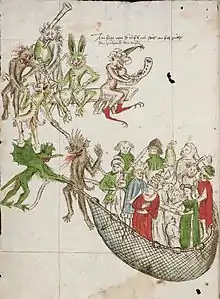Des Tüfels Segi
Des Tüfels Segi (des tuiffels segin "The Devil's Net", conventional Standard German title Des Teufels Netz[1]) is an Alemannic German satirical didactic poem of the early 15th century, most likely written during the years 1414–1420. The contents involve a long treatise on the estates (Stände) of traditional feudalism; the "devil's net" is an allegory for the various forms of vice affecting the various classes. The poem takes the form of a dialogue between a hermit and the devil. The theme of enumerating the various classes of society as all subject to sin and damnation is related to the Danse Macabre theme (enumerating them, somewhat less pessimistic, as all subject to death) which first developed at about the time of the poem's composition.

The text survives in divergent forms in four manuscripts; the longest version is in a Donaueschingen ms., extending to 13,657 verses, nearly twice as long as the shortest version[2] at a still appreciable 7,050 verses. A third ms. is both of intermediate length and age, Augsburg (formerly Maihingen) (1449, 9,979 verses).
See also
References
- sege(ne), segi being a Middle High German term for "net", in origin a loan of Latin sagena. Barack (1863:440, citing Pupikofer Thurgau, 1830) notes that during his time, segin was still a living word used by the fishermen of Lake Constance for the largest sort of net they used.
- Neustadt an der Aisch, mentioned 1782 by Schnizer, Der Kirchen-Bibliothek zu Neustadt an der Aysch Erste Anzeige, von den darinnen befindlichen Handschriften etc.
Literature
- Karl August Barack, Des Teufels Netz: satirisch-didaktisches Gedicht aus der ersten Hälfte des fünfzehnten Jahrhunderts (1863). Scan at WikiCommons
- Heinrich Werner, Des Teufels Netz. Überlieferung und Handschriftenverhältnis, Diss. Halle (Saale) 1911.
- Gudrun Friebertshäuser, Untersuchungen zu »Des Teufels Segi«, Diss. Freiburg i. Br. 1966.
- Anke Ehlers, Des Teufels Netz. Untersuchung zum Gattungsproblem (Studien zur Poetik und Geschichte der Literatur 35), 1973.
- Karin Lerchner, Des Teufels Netz, 2VL 9 (1995), 723-727.
- Franz-Josef Schweizter, Das Lehrgedicht »Des Teufels Netz« und die Konzilien von Konstanz und Basel, in: Flüeler, Rohde (eds.), Laster im Mittelalter, Volume 23 of Scrinium Friburgense / Scrinium Friburgense, ISSN 1422-4445, Walter de Gruyter, 2009, 125–135.
- Albrecht Classen: Death, Sinfulness, the Devil, and the Clerical Author. The Late Medieval German Didactic Debate Poem Des Teufels Netz and the World of Craftmanship, in: Death in the Middle Ages and Early Modern Times. The Material and Spiritual Conditions of the Culture of Death, hg. von Albrecht Classen (Fundamentals of Medieval and Early Moderln Culture 16), Berlin/Boston 2016, S. 277–296.
External links
- Descriptions of all known manuscripts at www.handschriftencensus.de
- Des Teufels Netz - Donaueschingen 113 (blb-karlsruhe.de)